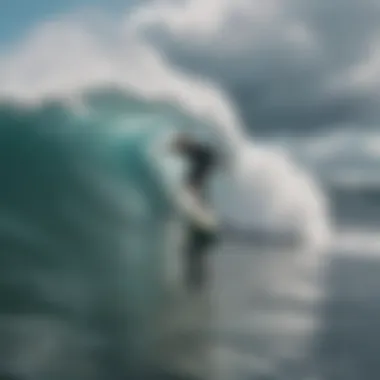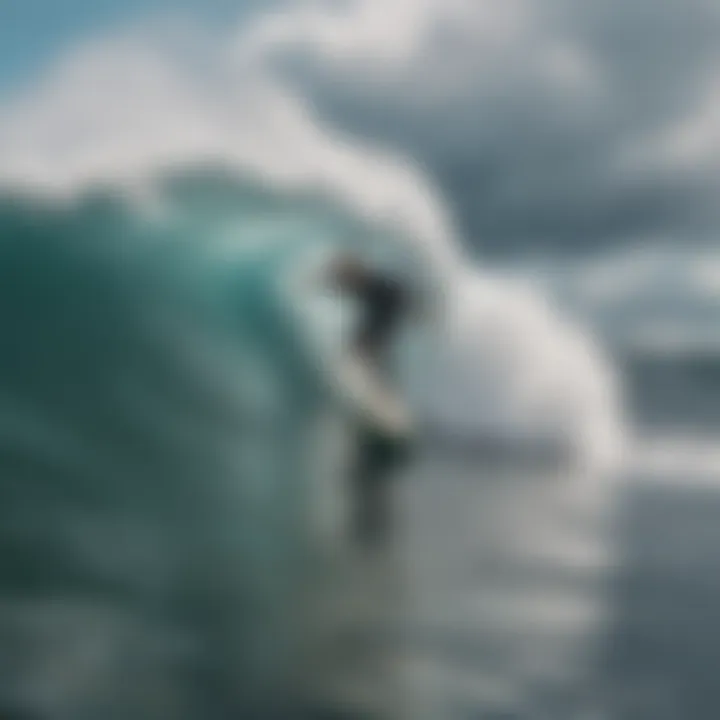Top Surfing Spots to Discover Worldwide


Intro
Surfing isn’t just a sport; it's a lifestyle. From the roaring waves of Pipeline in Hawaii to the tranquil shores of Cape Town, surf enthusiasts across the globe seek locations that not only provide the perfect wave but also enrich their experience with local culture and scenery.
The allure of surfing lies in its diversity, presenting a variety of destinations that cater to every type of surfer. Be it a novice with dreams of catching their first wave or a seasoned professional chasing the next championship, understanding the key features of each surfing location can profoundly enhance one's journey.
This guide dives into prime surfing destinations worldwide, delving into their unique characteristics, accessibility, and amenities. The narrative strives to provide insight into the heart and soul of surfing spots, allowing readers to align their surfing adventures with personal preferences and skill levels.
Gear Recommendations
Before hitting the waves, having the right gear is crucial. Below, we'll explore essential equipment for beginners and advanced surfers alike, ensuring a comprehensive understanding of what’s needed for a successful surfing experience.
Essential Gear for Beginners
- Surfboard: Start with a soft-top board to ensure safety. Longboards are typically ideal for beginners due to their stability.
- Wetsuit: Depending on the water temperature, a wetsuit can provide warmth and protect against abrasions.
- Leash: A good quality leash is vital to keep your board attached to your ankle, preventing it from floating away after a wipeout.
- Sun Protection: Sunscreen is non-negotiable, and consider wearing a UV rash guard for added protection.
- Surf Wax: This helps maintain grip on your board, eliminating the slip when you’re paddling out.
Advanced Equipment for Professionals
- High-performance Surfboards: Shortboards and fish boards crafted from lightweight materials enhance speed and maneuverability.
- Custom Wetsuits: Professional surfers often opt for tailored wetsuits, optimizing fit and flexibility.
- Surf Accessories: Drones for capturing the perfect wave, waterproof action cameras, and tech-enabled wristbands that track wave count and session details are now commonplace.
- Repair Kits: After nailing those tough rides, having a fiberglass repair kit ensures you spend more time surfing and less time fixing.
"Proper gear not only enhances performance but also elevates the overall surfing experience."
Techniques and Tips
Surfing isn’t solely about hitting the waves; there's an art to mastering the board. Various strategies can assist surfers in improving their skills and ensuring safety in the water.
Skill Improvement Strategies
- Practice Balance: Spend time on land balancing on your board; this can translate to improved stability in the water.
- Observe Experienced Surfers: Watch and learn from those who’ve honed their craft. Taking notes on their paddling techniques, take-off, and wave selection can offer insights that books may miss.
- Take Lessons: Whether in a local class or with a pro, gaining structured lessons can fast-track your skills.
Safety Practices and Guidelines
- Know Your Environment: Before entering the water, familiarize yourself with the conditions. Check for rip currents and local surf reports.
- Buddy System: Surfing with a partner enhances safety and makes for a more enjoyable experience.
- Respect Local Etiquette: Different beaches have various rules; understanding the pecking order in the lineup can prevent unnecessary confrontations.
By staying attuned to these tips and recommendations, surfers can cultivate their skills while ensuring a safe and enjoyable venture into the world of surfing.
Prelude to Surfing Destinations
Surfing is more than just a sport; it's a way of life embraced by millions around the globe. When considering the vast world of surfing destinations, one must acknowledge that these locations are not just about catching waves. They encompass rich cultural experiences, breathtaking scenery, and the thrill of adventure. This article delves into some of the prime surfing spots that cater to both novices and seasoned surfers, revealing the heart and soul of surfing culture in diverse corners of the world.
The importance of identifying the right surfing destination cannot be overstated. Each coast, beach, and wave brings its own character and set of challenges. From the soft, rolling waves of a beginner-friendly beach to the powerful, towering swells favored by experienced riders, finding the right match is crucial. Moreover, the local amenities, surfing schools, and community initiatives reflect the spirit of each location, enhancing the overall journey for surfers of all tastes.
The Allure of Surfing
The sheer thrill of riding a wave and feeling the ocean spray on one's face is hard to match. Surfing beckons individuals with the promise of freedom and exhilaration. The rush of balancing on a board as you navigate the swell speaks to the vulnerable yet vibrant connection between humans and nature. Surfing locations often draw people not only for the activity itself but also for the culture that surrounds it. For example, places like Hawaii have rich historical ties to the sport, serving as the birthplace of modern surfing. Hence, the allure transcends mere activity; it’s an exploration of local traditions, music, and even cuisine, all tied intricately to the surfing experience.
"Surfing isn’t just a pastime; it’s a lifestyle that binds communities and honors the ocean’s powerful spirit."
In essence, the allure of surfing lies in its transformative power. Each wave presents an opportunity for personal growth, whether that means improving skills, conquering fears, or connecting with like-minded enthusiasts.
Criteria for Choosing a Surfing Destination
Selecting a surfing destination involves several considerations to ensure that the experience is not just enjoyable, but also safe and rewarding. Here are a few factors to ponder:
- Skill Level: Starting out in a destination that caters to beginners with manageable waves can bolster confidence and foster learning. Conversely, seasoned surfers might seek out challenging breaks to test their skills.
- Wave Consistency: Certain locations are famed for their reliable surf conditions throughout the year. Researching seasonal wave patterns can optimize your surf trip satisfaction.
- Local Culture: Understanding the cultural dynamics of a surfing location enriches the experience. Engaging with local surf communities, attending events, and tasting traditional foods can create lasting memories.
- Accessibility: Evaluating how easily one can reach a destination is essential. Places with well-established travel routes, like flights or public transport, can simplify the planning process.
- Environmental Factors: Factors like water temperature, currents, and local wildlife may influence where one chooses to surf. Always stay informed regarding the environment to ensure safety.
Ultimately, each surfing journey is as unique as the individuals embarking on it. Balancing personal preferences with these criteria will lead to an unforgettable surfing destination experience.
North America
North America holds a significant place in the realm of surfing. With its diverse landscapes and surf conditions, it caters to a wide range of surfing styles and skill levels. From the towering waves of Hawaii to the mellow beach breaks of California, this continent offers an array of experiences that both novice and expert surfers cannot resist. In terms of accessibility, many prime spots are just a short drive from major cities, making it convenient for the adventurous spirit looking for the next challenge.
California Coast
Iconic Surf Spots
The California Coast has long been heralded as a surfing paradise. This area boasts famous surf spots like Huntington Beach, recognized as "Surf City, USA" for its consistent waves and vibrant surf culture. The excellent sun-soaked beaches, along with well-maintained breakwaters, make these locations attractive not just to seasoned veterans but also to newcomers eager to catch their first wave.
However, it isn’t just about the waves. The variety of surf schools and rental shops lining the coast provides beginners with a chance to learn from experienced instructors, granting them the tools to thrive even as the surf gets busy. On the flip side, some spots can become crowded, which might deter those seeking solitude on the waves.
Local Culture and Events
The cultural scene around California surfing is lively, colorful, and welcoming. Local events such as surf contests, music festivals, and beach clean-ups foster a sense of community among surfers. Attending these gatherings—like the U.S. Open of Surfing—allows surfers to connect with locals and fellow enthusiasts, creating bonds that often last a lifetime. Plus, it highlights the important relationship between surfing and environmental conservation efforts, making it a worthwhile endeavor.
Events like these enrich the surfing experience, adding layers of enjoyment beyond just riding waves. However, planning around events can sometimes complicate travel, as accommodations may be booked up more quickly during peak festival times.
Best Time to Visit
Determining the best time to visit the California Coast requires a bit of finesse. Generally speaking, fall usually offers the most consistent waves, as summer swells taper off and winter storms haven't quite rolled in. Surfers often recommend September through November as the golden months for finding excellent conditions.
Yet, those hoping to escape the summer crowd may find the early mornings in spring to be quite rewarding. Early risers can often score some peaceful sessions before the tourists hit the beach. Knowledge of local wind patterns is also crucial; even a light breeze can turn a perfect wave into a choppy mess which might ruin a session.
Hawaii – The Birthplace of Surfing
Famous Surf Breaks
Hawaii is acknowledged globally as the birthplace of surfing, and it's no wonder why it attracts enthusiasts from every corner of the Earth. Renowned surf breaks like Pipeline on Oahu's North Shore or Hanalei Bay on Kauai offer some of the most thrilling and challenging waves.
What makes these breaks so famous isn't just their size but their unique characteristics; they provide opportunities for surfers to push their limits against the ocean's might. Of course, these breaks demand respect as they come with their own set of dangers, making preparation invaluable.
Travel Tips
If you're headed to Hawaii, it pays to come armed with knowledge. Ocean safety, gear rentals, and local surf etiquette are just a few aspects to keep in mind. It's also beneficial to be aware of seasonal weather patterns; winter can bring massive, formidable waves, while summer tends to ease up. Locals often have the insider scoop on lesser-known spots, so don’t hesitate to chat them up.
Navigating the islands can be a bit tricky due to varying surf conditions, so a plan that considers time of day, tides, and expected swells is wise.
Cultural Significance


The importance of surfing in Hawaiian culture is unmatched. It goes beyond recreational activity; it's intertwined with history and tradition. For native Hawaiians, surfing was once a rite of passage, ritualized in ceremonies involving spirituality and respect for the ocean. Today, the practice has evolved, yet it still holds significant meaning as part of the local identity.
Learning not just the sport but these cultural aspects adds depth to any surfing experience, while also nurturing respect for the ocean and Hawaiian heritage, elevating surf trips to learning ones.
East Coast Gems
Top Locations
The East Coast is often overlooked in favor of its Western counterpart but is dotted with potential gems like Montauk in New York or Cocoa Beach in Florida. Each offers unique surf opportunities depending on the season; Atlantic swells can be quite forgiving, making them ideal for those just getting their feet wet.
These spots can be less crowded than West Coast locations, particularly during off-peak times, which can be advantageous for surfers wanting to practice their skills without the buzz of the hasty crowd.
Seasonal Variations
Understanding seasonal variations on the East Coast is crucial for anyone looking to plan that perfect surf getaway. Summer often sees more consistent smaller waves, suitable for beginners, while fall brings swells that can challenge even the most seasoned riders. Winter, on the other hand, presents its own unique suite of challenges with much colder water temperatures and heavier surf.
Each season offers a different vibe—whether you're relishing the fresh summer breeze or embracing the brisk chill of winter, it's all part of the package.
Surf Competitions
East Coast surf competitions have gained recognition for their skillful showcases and community spirit. Events like the Eastern Surfing Association (ESA) competitions offer local surfers a platform to compete and grow within the sport. These competitions bring together passionate communities and foster an environment for surfers of all levels.
Competing can also offer insight into local conditions and approaches to surfing. However, keeping an eye on the competition schedule and potential changes in conditions is vital for any attending surfers.
In summary, North America's prime surfing spots have unique aspects worth exploring. From the famous Hawaiian breaks to the hidden gems along the East Coast, each destination offers a rich tapestry of experiences that extend beyond merely catching waves.
Central and South America
Central and South America offer surfers an array of stunning locations that cater to all skill levels, blending natural beauty with a rich cultural fabric. From the warm waters of Costa Rica to the iconic breaks of Peru, this region is a treasure trove for surf enthusiasts. The waves here aren't just about the thrill; they're a gateway to understanding local traditions, climate conditions, and the surfing lifestyle. The warm climates, diverse landscapes, and hospitable locals add to the allure, making it a prime destination for surfers looking to catch both great waves and unique experiences.
Costa Rica's Surf Paradise
Popular Beaches
Costa Rica is famous for its pristine beaches that draw surfers from around the globe. Beaches like Tamarindo and Santa Teresa offer more than just waves. These spots have consistent surf year-round, making them ideal for any surfer eager to strap on their board. The lively atmosphere combined with warm waters makes these beaches a top choice for novice and advanced surfers alike.
A standout characteristic of these beaches is their accessibility. Many of them can be reached with ease from popular tourist areas, allowing surfers to hit the waves with minimal hassle. However, it’s worth noting that certain beaches can become packed, especially during peak surf season. This crowd factor can sometimes limit the experience, but it also fosters a vibrant community feeling.
Surfing Schools
The rise of surfing schools in Costa Rica has made it a haven for beginners. These institutions not only teach the technical aspects of surfing but also instill a respect for the ocean and its currents. Schools such as Witch's Rock Surf Camp offer a comprehensive curriculum, taking both local environmental factors and safety into consideration.
What makes these schools particularly appealing is their integration into the local surf culture; instructors often share stories and tips about nearby surf spots and best times to catch the waves. Though the cost of lessons can add up, the knowledge gained often leads to safer and more enjoyable surfing experiences.
Sustainability in Surfing
Sustainability is an important theme in Costa Rica's surfing scene, with many local businesses striving to protect their beautiful coastlines. Many surf schools and camps are adopting eco-friendly practices, such as using biodegradable products and organizing beach clean-ups. This commitment to the environment not only helps keep the beaches pristine but also educates surfers on the importance of conservation.
One unique feature of this sustainability effort is the community's emphasis on responsible surfing decisions, ensuring that the natural ecosystems remain unharmed. However, navigating through various eco-initiatives can be tricky for newcomers, as misinformation sometimes leads to less effective efforts.
Peru's Unique Breaks
Notable Surf Locations
Peru is home to some of the most distinguished surf spots, including Punta Hermosa and Mancora. These locations are characterized by their dramatic landscapes and consistent surf conditions, suitable for various skill levels. The left-hand breaks offer exhilarating rides, attracting intermediate and advanced surfers eager to test their mettle. An essential characteristic of these notable spots is their seasonal fluctuations; certain waves are better during specific times of the year, making it advisable for surfers to plan their visits accordingly.
While these locations remain popular, surfers must be prepared for the local conditions that can change quickly. Being aware of tides, swells, and local customs is essential for a fulfilling experience.
Local Insights
Local insights can be a surfer's best friend. Engaging with local surfers provides invaluable knowledge about lesser-known breaks and when to surf them. Additionally, locals can offer insights on cultural significance and etiquette that are crucial when surfing in a new country.
Sharing experiences with local surfers deepens the connection to the surf culture. However, understanding the nuances of local etiquette can sometimes be a challenge for outsiders, as they may inadvertently breach common practices within the surfing community.
Conditions Overview
The surfing conditions in Peru are often dictated by surrounding geography and ocean currents. The Pacific coastline experiences varied swell patterns, which can result in ideal conditions for surfing. Local weather patterns can also affect wave quality, with the best surf often occurring during the southern hemisphere winter months. A key characteristic of conditions overview in Peru is the strength and frequency of swells, making it crucial for surfers to stay informed.
While many surfers find themselves enamored with the reliable waves, the conditions can be daunting for less experienced surfers. Knowledge of local hazards, including rip currents and rocky reefs, becomes essential to ensure safety on the water.
Australia and New Zealand
Australia and New Zealand present a compelling surfing landscape, renowned for their diverse coastlines, vibrant surf culture, and unique environmental features. These regions hold a special place in the hearts of surfers worldwide, and not just for the waves. Both countries boast a range of surf spots catering to all levels, from beginners to seasoned pros. It means whether you're catching your first wave or tackling world-class breaks, these destinations offer something special.
The Gold Coast
Best Waves
The Gold Coast is synonymous with some of the best waves in the world. From the powerful breaks at Snapper Rocks to the playful swells at Burleigh Heads, surfers have no shortage of options. The consistency and quality of the swell here is often unparalleled, driven by favorable geography and wind patterns. This area's waves provide an exhilarating ride that draws surfers from every corner of the globe.
One might say the key characteristic of the Gold Coast’s waves is their versatility. Experienced surfers appreciate the challenge of the reef breaks, while newcomers can find more forgiving beach breaks. What makes these waves particularly special is the sheer thrill they offer, allowing surfers to maximize their skills in a breathtaking setting.
However, there are a few things to consider. Crowds can be a drawback, especially during peak season. It's not uncommon to find yourself sharing the water with dozens of other surfers, which can be intimidating for some.
Surf Culture
Surf culture in the Gold Coast is vibrant and infectious. It’s a lifestyle, not just a sport. The warm climate and lifestyle attract surfers and beach lovers, creating a community interconnected by the love for the ocean. Local surf shops, cafes, and markets radiate that unique vibe. Here, surfing isn’t just a hobby; it’s a way of life woven intimately into the local fabric.
One of the defining features of this culture is its inclusiveness. From surf schools that welcome all skill levels to community events and beach clean-ups, there's a palpable sense of belonging. Plus, the local surf events often celebrate local talent, highlighting up-and-coming surfers who could be the next big names. However, one must be cautious in terms of increasing commercialization that sometimes overshadows the genuine spirit of surf communities.
Events and Competitions
The surfing events and competitions held on the Gold Coast are an essential part of this region's allure. The world-famous Quiksilver Pro serves as a highlight, drawing elite surfers and massive crowds. These competitions not only showcase the talents of professional surfers but also draw attention to the area's stunning qualities.
Such events can be beneficial in promoting the sport and encouraging local tourism. They often foster a sense of community, bringing people together to celebrate their shared love of surfing. Additionally, these competitions can serve as a platform for new talent to shine, giving emerging surfers a chance to make their mark.
On the flip side, large events can bring disruptions. Increased foot traffic and noise can sometimes detract from the natural beauty and tranquility that surfers often seek. Balancing such events with the local lifestyle is key to preserving what makes the Gold Coast special.


New Zealand's Untouched Coastlines
Exploring the North Island
New Zealand's North Island offers a unique surfing experience nestled among its untouched coastlines. Surfers often enjoy diverse surf conditions, with spots like Raglan renowned for its left-hand breaks. The scenic beauty of the North Island’s landscapes adds an undeniably picturesque backdrop to a surfing adventure.
The North Island is characterized by its rich cultural heritage, particularly that of the Māori people, which brings a distinct flavor to the surfing experience. Many local surf schools, such as those found in Raglan or Piha, emphasize environmental respect and cultural appreciation. Such elements help create an immersive experience, making it a valuable choice within this article's exploration.
However, the remoteness of some surf spots can be both a blessing and a challenge. Those seeking solitude might find bliss, but navigating the regions can sometimes require proper planning and transport to access high-quality waves.
South Island Highlights
When it comes to the South Island, the stunning landscapes are just one of the things that set it apart. Famous for its rugged coastlines, places like Pigeon Bay and Kaikoura offer surf spots that feel almost untouched. These areas appeal to those looking for an adventure far off the beaten path, surrounded by spectacular scenery.
A key characteristic of the South Island is its varied surf conditions influenced by changing weather systems, which can be exciting for those who thrive on unpredictability. Moreover, a less touristy vibe invites surfers to embrace a more intimate relationship with nature.
But with great beauty often comes unpredictability; the weather can change in the blink of an eye, so surfers need to be prepared for all that Mother Nature throws their way.
Surfing Communities
Communities in New Zealand are essential to the surfing experience. From passionate local surfers who live and breathe their craft to welcoming surf schools keen on mentoring newcomers, these communities foster a spirit of camaraderie and support. Visitors often leave feeling more like part of a family than just tourists.
Each surf town tends to have its own character, shaped by its people. Events hosted by local surf clubs not only bolster the community but also encourage local talent. The unique approach of local surfers in New Zealand, focusing on safety and sustainability, underscores their commitment to preserving the environment, crucial for the future of surfing.
On the downside, such close-knit communities can feel exclusive at times, especially for travelers unfamiliar with the local customs. It’s vital for visitors to be respectful and open to learning about the local traditions.
In summary, when considering surf destinations, Australia and New Zealand stand out for their wave quality, rich culture, and unique community ties, offering endless exploration opportunities for surfers around the globe.
Europe
Europe is a treasure trove of diverse surfing experiences, showcasing a melting pot of cultures, climates, and surf conditions. Travelers and surf enthusiasts flock here not just for the surf but for the rich tapestry of history, breathtaking landscapes, and vibrant communities that add value to the surfing experience. The unique geographical features of Europe create endless opportunities for surfers of all levels, making it a top choice when exploring prime surfing destinations.
Portugal's Surf Revolution
Portugal, often regarded as Europe’s surf capital, has seen a significant revolution in its surf culture over recent years. The coastline is dotted with beaches that cater to different surfing skills and styles, and the warm climate makes it an inviting place for year-round surfing.
Key Surf Spots
When looking at key surf spots in Portugal, we can't overlook locations like Nazaré, known for its gigantic waves, and the more gentle breaks found at Praia do Amado. Each place offers its own flavor. Nazaré is famed for attracting the world’s best big-wave surfers; its waves can reach heights that defy imagination.
The unique feature of the ocean floor in Nazaré creates conditions that can swell waves to monstrous sizes, making it a playground for experienced surfers. In contrast, the sandy shores of Praia do Amado offer a safer environment for beginners and casual surfers looking to hone their skills. These spots are essential because they shine a light on the versatility of Portugal’s coastline. Each wave tells a different story, catering to all in the surf family.
Unique Conditions
The unique conditions found in Portugal stem from its geographical position, where the North Atlantic swells meet a rugged coastline. This mix produces varying wave heights and types, appealing to surfers from everywhere. The prevailing winds often create offshore conditions that keep the waves clean and rideable. As a result, the country can host a strong surf scene, with many surfers benefiting from consistent swells throughout the year. However, with these unique conditions comes the challenge of understanding local weather patterns and tides, which can change rapidly.
Cultural Elements
Surf culture in Portugal is vibrant and influential, intertwining with local traditions and community values. From traditional coastal fishing towns to modern surf camps, the blend creates a unique ambiance that enriches the surf experience. One key cultural feature is the celebration of local food and music, which often mirrors the easy-going and adventurous spirit found in surf culture.
Surfing events and competitions are a common occurrence, tying communities closer together. While some may find the commercialization of surf culture overwhelming, many appreciate how it supports local economies and emphasizes sustainable practices.
The French Atlantic Coast
The French Atlantic coast is another beacon of surf culture in Europe, renowned for its stunning beaches and lively surf community. The coast stretches from the region of Brittany right down to the Spanish border. It is well-loved for its beach breaks and point breaks, offering something for everyone.
Surfing Festivals
France hosts a variety of surfing festivals throughout the year, drawing in both locals and international visitors. These festivals are more than just competitions; they celebrate the spirit of surfing and bring together surfers from different backgrounds. Events often include music, food stalls, and expos showcasing the latest surf gear, creating a festive atmosphere.
The unique aspect of these festivals is their ability to highlight local talent while encouraging newcomers to join in the fun. Participating in these events can influence a surfer’s journey, as they provide insights into the local surf scene and foster a sense of camaraderie among surfers, amateurs and pro alike.
Local Surf Schools
Across the French coastline, local surf schools are scattered, offering guidance and lessons for aspiring surfers. With experienced instructors, these schools teach vital skills that lie at the heart of safe surfing. Each school reflects the community vibe and surf culture, with many emphasizing eco-friendly practices and local knowledge.
One advantage of these schools is the personalized attention they provide, allowing surfers to learn at their own pace amidst picturesque surroundings. However, the popularity of certain spots can lead to crowding during peak times, challenging novices as they navigate the waters.
Travel Recommendations
Traveling along the French Atlantic coast comes with various needs and wants. It’s crucial to consider timing your visits. Autumn and spring provide the best surf conditions, with fewer crowds. Travelers can also enjoy unique opportunities to experience the geographical beauty and local cultures without the summer rush.
A unique travel tip is to explore less popular coastal towns like Anglet or Hossegor, where surfers can seek lesser-known surf spots that offer incredible waves without the buzz of tourist hotspots. This area also boasts charming cafes and boutiques that elevate the overall travel experience.
In summary, Europe presents a multitude of enriching surfing destinations. With Portugal leading the charge, not far behind is the French Atlantic coast, each offering unique adventures that cater to every kind of surfer.
As Asia Emerges as a Surfing Hub
The world of surfing is evolving, and Asia is catching the wave in remarkable ways. This shift towards Asian surfing destinations speaks volumes about their increasing importance and appeal. The vibrant surf culture emerging in locations like Bali, Indonesia, and the Philippines not only attracts seasoned surfers but also lures in novices eager to ride the swells.
With a wide variety of surfing conditions, scenery, and local cultures, Asia is becoming a go-to region for surf lovers globally. The benefits are immense; affordable costs, friendly locals, and diverse landscapes come together to create a uniquely enriching experience. As surfing grows in popularity, so does the focus on preserving the natural beauty of these coastal areas, making responsible surfing practices important for sustainable tourism.
Bali's Allure
Popular Surf Spots
Bali is undeniably a jewel in the crown of surfing. When one thinks of popular surf spots, places like Kuta, Uluwatu, and Canggu immediately spring to mind. Kuta Beach is packed with tourists, yet it’s perfect for beginners due to its long rolling waves. Uluwatu, on the other hand, is renowned for its more challenging waves, attracting experienced surfers from all over the world. The unique feature of these surf spots is their diversity; from gentle swells to powerful breaks, there’s something for everyone.
One of the standout characteristics that makes Bali’s surf spots beneficial is their consistency throughout the year. Surfers can often find good waves regardless of the season, which is a huge bonus.
Local Craft and Lifestyle
Surfing in Bali is not just about the waves; it’s also an immersion into a rich local craft and lifestyle. Many surfers take a break from riding the waves to explore local artisan markets, where handcrafted surfboards and traditional Balinese crafts are sold. This aspect enriches the surfing experience, allowing visitors to engage with the local culture in a meaningful way.
What's beneficial about this lifestyle is its authenticity. The connection between the surf community and local artisans showcases how surfing can coexist harmoniously with cultural heritage. While the development of commercial surf shops is growing, spending time in local markets helps maintain a balance between tourism and tradition.
Best Time to Surf


Understanding the best time to surf in Bali can greatly enhance the overall experience. The dry season, which typically runs from May to September, is often regarded as the prime time for surfing. During these months, the swells are generally more powerful and consistent, making them ideal for both intermediate and advanced surfers.
However, the wet season, from October to April, should not be dismissed. This period can offer excellent waves and far fewer crowds, making for a more intimate surfing experience. The unique feature here is flexibility; surfers can choose their environment based on personal preferences—whether seeking the thrill of competition or a quieter exploration of hidden spots.
Surfing in the Philippines
Hidden Options
The Philippines is like a treasure chest of hidden surf spots waiting to be uncovered. While places like Siargao gain immense popularity, lesser-known destinations like Calicoan Island or San Juan are gems that shouldn't be overlooked. These hidden options provide surfers with a chance to connect with nature away from the hustle and bustle.
A key characteristic of these locations is their rugged beauty, often characterized by unspoiled beaches and picturesque backdrops. The advantage, of course, is the isolation—less crowded waves allow for a more personal experience. However, access can sometimes be tricky, with fewer amenities available compared to more popular spots.
Environmental Conservation
As surfing continues to grow in the Philippines, awareness of environmental conservation follows closely behind. Many local groups are actively engaged in cleaning beaches and educating surfers on sustainable practices. This awareness contributes to the overall goal of preserving natural landscapes while providing surfers with clean and beautiful locations to enjoy.
Promoting environmental conservation is beneficial for both the surfers and the communities they visit. It fosters a respectful relationship between tourists and locals, ensuring that these captivating spots remain pristine for generations to come. Notably, it encourages surfers to actively participate, making them stakeholders in the preservation of their playground.
Local Communities
Surfing in the Philippines is deeply interwoven with local communities, and the impact is both enriching and empowering. When surfers support local businesses—be it staying in family-run accommodations, eating at local eateries, or taking lessons from community instructors—they directly contribute to local economies.
The local touch is vital; these communities often share invaluable insights about surf conditions, hidden spots, and local customs. This engagement enhances the overall experience while building goodwill and fostering relationships between visitors and locals. However, a word of caution: being respectful and understanding cultural differences is essential in these interactions.
"Surfing grows in regions like Asia not just through the swell of waves but through waves of connection with local cultures and practices."
Understanding Surfing Conditions
Understanding the various conditions of surfing is paramount for anyone looking to enjoy this exhilarating sport. Surfing is not just about catching a wave; it’s about respecting nature's whims and working with it to get the most out of your experience. Knowledge of wave patterns, tides, weather influences, and local hazards is crucial not only for safety but also for honing one’s skills on the water. Acknowledging these elements can significantly impact the quality of your surf sessions, allowing surfers to choose the best times and places to ride the waves.
Wave Patterns and Tides
Wave patterns, dictated by the wind, ocean currents, and geographical features, are the heart and soul of surfing. These patterns determine the type of waves one can expect at any given surf spot.
For example, when the wind blows consistently offshore, it allows waves to form and break cleanly, leading to those sought-after glassy conditions. On the contrary, onshore winds can create choppy and less desirable surfing conditions. Understanding tides is equally as important. They affect how waves break and how accessible certain surf spots are at different times of the day. Some areas may produce better waves at high tide, while others work best during low tide. Keeping a tide chart in your bag could save you a headache, or even a sore back after a long paddle out in subpar conditions.
Weather Influences
Weather does more than just set the mood for your beach day; it significantly influences the ocean's state and wave consistency. Surfers need to keep an eye on the local weather forecasts, as storms further out at sea can create swells months in advance. For instance, a hurricane many miles away could mean surfable waves for beachgoers weeks later.
Thus, surfers often check buoy reports, which provide information about wave height and swell direction. It's the tip of the iceberg, really; being astute about weather systems allows surfers to look beyond their immediate surroundings. They learn to anticipate conditions, making them better prepared to take advantage of immersive surfing experiences.
Being Aware of Local Hazards
Every surf destination comes with its own set of unique local hazards that surfers must be aware of. Rip currents, for instance, pose a significant risk. These powerful channels of water can pull even the strongest swimmer away from shore in a matter of seconds. Knowledge is power here; learning how to identify a rip current and understanding how to escape can be a lifesaver.
Moreover, some areas may have hidden rocks or sharp reefs, while others could have marine life, such as jellyfish or even sharks, to keep an eye on. Different countries may have different regulations and norms regarding surf safety—this is where local knowledge comes in handy. Local surfers or instructors often have valuable insights that can help newcomers navigate potential hazards.
Being informed about wave patterns, weather influences, and local risks empowers surfers to make educated decisions, ensuring a safer and more enjoyable surfing experience.
A Focus on Surf Culture
Surfing is more than a sport; it is a way of life deeply intertwined with local cultures around the globe. Whether one finds themselves riding the waves in California, bonding with fellow surfers in Bali, or participating in competitions in Australia, the culture surrounding surfing enriches the experience. Through this section, we delve into the dynamics of surf culture, exploring how it shapes local communities, fosters connections among practitioners, and integrates sustainability practices into the fabric of surfing life.
The Role of Surfing in Local Communities
Surfing has an undeniable impact on local communities, functioning as a cultural thread that binds people together. In many coastal towns, the surf community is pivotal in shaping identities and lifestyles. From the Bahamas to the shores of Portugal, surfers often unite over their love for the ocean.
Many small towns have economies that rely heavily on surfing tourism, leading to the creation of jobs in surf schools, equipment rentals, and hospitality sectors. Events like surf contests attract visitors, generating revenue while simultaneously fostering a sense of pride among locals. In areas like the North Shore of Oahu, residents live and breathe the sport, with families passing down skills from generation to generation. This connection creates opportunities for mentoring and nurturing young talent, ensuring that the spirit of surfing remains vibrant.
- Surf communities often emphasize values such as respect for nature and camaraderie.
- Social gatherings, celebrations, and beach cleanups further strengthen the bonds among surfers in any locale.
Participating in Local Events and Competitions
Local surf competitions and events not only spotlight the skills of individual surfers but also serve as important cultural gatherings. They offer a platform for both newcomers and seasoned professionals to showcase their talents. Moreover, these events bring visitors, specifically locals, together, underpinning the economic and social fabric of surf towns.
In places like Jeffrey's Bay and the UK Surfing Championships, the atmosphere buzzes with energy, friendships formed over shared passions. Attending such gatherings can also be a learning experience, with aspiring surfers absorbing tips and techniques from experienced counterparts while fostering a sense of belonging.
- Events might include both casual contests and professional championships.
- Local food vendors and artisans often stand alongside competitions, promoting regional culture further.
"Participating in surf events is like joining a big family where everyone supports one another, whether you are just starting out or a pro."
Sustainability Initiatives in Surfing
The growing awareness of environmental issues within the surfing community has led to innovative sustainability initiatives across the globe. Surfers depend heavily on healthy oceans and beaches, prompting many to take on the responsibility of conservation. This initiative not only protects their local surf spots but also promotes awareness amongst participants visiting from afar.
Efforts range from organizing beach clean-ups to collaborating with non profits focused on ocean conservation. Programs that encourage eco-friendly surfboard manufacturing and the use of sustainable materials are also emerging. Several businesses are making strides to minimize their environmental footprints, ensuring that future generations can share in the beauty of the waves.
- Local initiatives often partner with schools, promoting environmental education through surfing programs.
- Many surf schools have integrated sustainability into their curriculum, teaching students about ocean health alongside riding techniques.
In closing, surf culture is not just about catching waves but is steeped in community values, competition, and a sincere commitment to the environment. It ties together diverse groups and fosters connections that go beyond the ocean, ensuring surfing remains an enduring and enriching pursuit for all.
Ending: The Future of Surfing Destinations
The world of surfing is changing fast. As environmental awareness grows and travel preferences shift, surfers need to look carefully at where they choose to ride the waves. The future of surfing destinations hinges not just on the quality of the waves but also on sustainability, accessibility, and local community engagement.
Understanding this balance is crucial. Every new surfer, from rookies to seasoned pros, plays a role in shaping the future landscape of surfing. Choices made today will echo through the surf culture of tomorrow.
"A surfer's paradise is only as good as the ocean it sits by and the community that supports it."
Emerging Destinations to Watch
Surfing enthusiasts should keep an eye out for emerging hot spots that promise to deliver both thrilling waves and rich cultural experiences. Some of these nascent destinations, often overshadowed by their legendary counterparts, are quickly gaining attention. Here are a few notable mentions:
- Morocco's Taghazout: Known for its right-hand point breaks, Taghazout is becoming renowned for its surf camps and welcoming vibe. The local culture is distinct, making it more than just a surfing hub.
- El Salvador’s Punta Roca: While not as famous as some other destinations, this spot offers consistently good conditions throughout much of the year and a local surf culture that is both vibrant and supportive.
- Sri Lanka's Hikkaduwa: With a growing surf community and stunning beaches, Hikkaduwa brings a blend of relaxation and adventure, alongside opportunities to engage with local traditions.
These places not only cater to the thirst for adrenaline but also present potential for deeper engagement with local surf communities. As they rise in popularity, it’s vital for surfers to support responsible tourism practices in these regions.
Balancing Growth and Conservation
As more surfers flock to lesser-known destinations, the challenge remains to balance growth with the need for conservation. Not just for the sake of keeping waves pristine but also for the sustainability of local economies and ecosystems. Here are some key points to consider:
- Local Impact: Rapid growth can overwhelm local resources, affecting everything from water quality to community health. Surfers need to respect local customs and practices, making sure their presence positively contributes to the area.
- Environmental Protection: Collaboration with local environmental groups is essential. They often have initiatives aimed at protecting coastlines and ocean health. Surfers can participate in beach clean-ups, educate others about marine life, and advocate for practices that minimize ecological footprints.
- Sustainable Surf Practices: Using eco-friendly gear, carbon-neutral transportation, and local accommodations helps minimize the surf industry's impact. As consumers, surfers can make choices that support brands committed to sustainability.
Finding this balance ensures that surf destinations thrive without compromising the unique environments that attract adventurers in the first place. The future of these iconic locations—and the joy of surfing—is in our hands.













